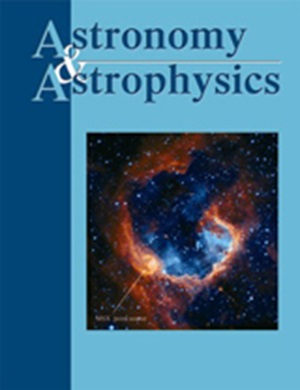A unified accretion-ejection paradigm for black hole X-ray binaries
IF 5.8
2区 物理与天体物理
引用次数: 4
Abstract
Context. We proposed in paper I that the spectral evolution of transient X-ray binaries (XrB) is due to an interplay between two flows: a standard accretion disk (SAD) in the outer parts and a jet-emitting disk (JED) in the inner parts. We showed in papers II, III, and IV that the spectral evolution in X-ray and radio during the 2010–2011 outburst of GX 339-4 can be recovered. However, the observed variability in X-ray was never addressed in this framework. Aims. We investigate the presence of low frequency quasi-periodic oscillations (LFQPOs) during an X-ray outburst, and address the possible correlation between the frequencies of these LFQPOs and the transition radius between the two flows, rJ. Methods. We select X-ray and radio data that correspond to 3 outbursts of GX 339-4. We use the method detailed in Paper IV to obtain the best parameters rJ(t) and ṁin(t) for each outburst. We also independently search for X-ray QPOs in each selected spectra and compare the QPO frequency to the Kepler and epicyclic frequencies of the flow in rJ. Results. We successfully reproduce the correlated evolution of the X-ray spectra and the radio emission for 3 different activity cycles of GX 339-4. We use a unique normalisation factor for the radio emission, f∼R. We also report the detection of 7 new LFQPOs (3 Type B, and 4 Type C), to go along with the ones previously reported in the literature. We show that the frequency of Type C QPOs can be linked to the dynamical JED-SAD transition radius rJ, rather than to the optically thin-thick transition radius in the disk. The scaling factor q such that νQPO ≃ νK(rJ)/q is q ≃ 70 − 130, a factor consistent during the 4 cycles, and similar to previous studies. Conclusions. The JED-SAD hybrid disk configuration not only provides a successful paradigm allowing us to describe XrB cycles, but also matches the evolution of QPO frequencies. Type C QPOs provide an indirect way to probe the JED-SAD transition radius, where an undetermined process produces secular variability. The demonstrated relation between the transition radius links Type C QPOs to the transition between two different flows, effectively tying it to the inner magnetized structure, i.e., the jets. This direct connection between the jets’ (accretion-ejection) structure and the process responsible for Type C QPOs, if confirmed, could naturally explain their puzzling multi-wavelength behavior.黑洞X射线双星的统一吸积-抛射范式
背景我们在论文 I 中提出,瞬态 X 射线双星(XrB)的光谱演化是由两股气流相互作用造成的:外层是标准吸积盘(SAD),内层是喷流发射盘(JED)。我们在论文 II、III 和 IV 中表明,可以恢复 GX 339-4 在 2010-2011 年爆发期间的 X 射线和射电光谱演变。然而,在这一框架中从未处理过观测到的 X 射线变异性。我们研究了 X 射线爆发期间低频准周期振荡(LFQPOs)的存在,并探讨了这些 LFQPOs 的频率与两个流之间的过渡半径 rJ 之间可能存在的相关性。我们选择了与 GX 339-4 的 3 次爆发相对应的 X 射线和无线电数据。我们使用论文 IV 中详述的方法来获得每个爆发的最佳参数 rJ(t) 和 ṁin(t)。我们还在每个选定的光谱中独立搜索 X 射线 QPO,并将 QPO 频率与 rJ 中的开普勒频率和流的外循环频率进行比较。我们成功地再现了 GX 339-4 3 个不同活动周期的 X 射线光谱和射电辐射的相关演变。我们为射电辐射使用了一个独特的归一化因子 f∼R。我们还报告探测到了 7 个新的 LFQPO(3 个 B 型,4 个 C 型),以及之前文献中报告的那些。我们的研究表明,C型QPO的频率与JED-SAD的动态转换半径rJ有关,而不是与磁盘中的光学薄厚转换半径有关。νQPO≃νK(rJ)/q的缩放因子q为q≃70 - 130,这一因子在4个周期中保持一致,与之前的研究结果相似。JED-SAD混合盘配置不仅为我们描述XrB周期提供了一个成功的范例,而且与QPO频率的演变相吻合。C型QPO为探测JED-SAD过渡半径提供了一种间接方法,在这种方法中,一个未确定的过程产生了周期性变化。过渡半径之间的关系证明,C 型 QPO 与两种不同气流之间的过渡联系在一起,有效地将其与内部磁化结构(即喷流)联系在一起。如果喷流(吸积-喷射)结构与产生C型QPO的过程之间的这种直接联系得到证实,就可以很自然地解释它们令人费解的多波长行为。
本文章由计算机程序翻译,如有差异,请以英文原文为准。
求助全文
约1分钟内获得全文
求助全文
来源期刊

Astronomy & Astrophysics
ASTRONOMY & ASTROPHYSICS-
自引率
27.70%
发文量
0
期刊介绍:
Astronomy & Astrophysics is an international Journal that publishes papers on all aspects of astronomy and astrophysics (theoretical, observational, and instrumental) independently of the techniques used to obtain the results.
 求助内容:
求助内容: 应助结果提醒方式:
应助结果提醒方式:


